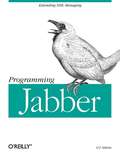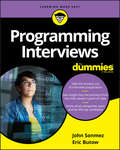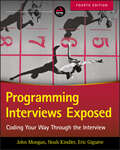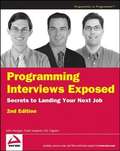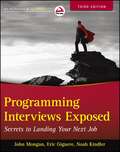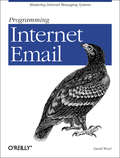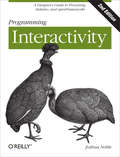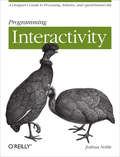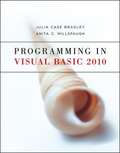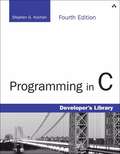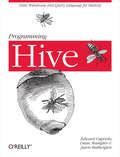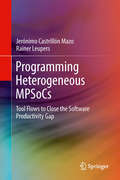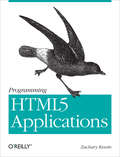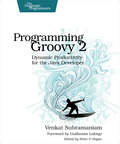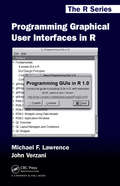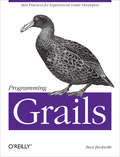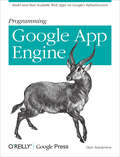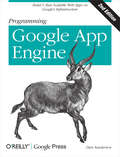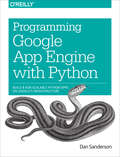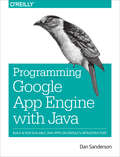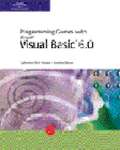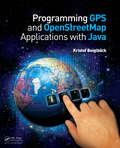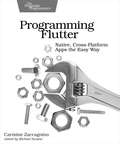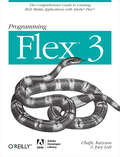- Table View
- List View
Programming Jabber
by D. J. AdamsProgramming Jabber offers developers a chance to learn and understand the Jabber technology and protocol from an implementer's point of view. Detailed information of each part of the Jabber protocol is introduced, explained, and discussed in the form of mini-projects, or simple and extended examples in Perl, Python, and Java. This book provides the foundation and framework for developers to hit the ground running, and is the essential book on Jabber.
Programming Interviews For Dummies
by Eric Butow John SonmezGet ready for interview success Programming jobs are on the rise, and the field is predicted to keep growing, fast. Landing one of these lucrative and rewarding jobs requires more than just being a good programmer. Programming Interviews For Dummies explains the skills and knowledge you need to ace the programming interview. Interviews for software development jobs and other programming positions are unique. Not only must candidates demonstrate technical savvy, they must also show that they’re equipped to be a productive member of programming teams and ready to start solving problems from day one. This book demystifies both sides of the process, offering tips and techniques to help candidates and interviewers alike. Prepare for the most common interview questions Understand what employers are looking for Develop the skills to impress non-technical interviewers Learn how to assess candidates for programming roles Prove that you (or your new hires) can be productive from day one Programming Interviews For Dummies gives readers a clear view of both sides of the process, so prospective coders and interviewers alike will learn to ace the interview.
Programming Interviews Exposed: Coding Your Way Through the Interview
by John Mongan Eric Giguere Noah Suojanen KindlerAce technical interviews with smart preparation Programming Interviews Exposed is the programmer’s ideal first choice for technical interview preparation. Updated to reflect changing techniques and trends, this new fourth edition provides insider guidance on the unique interview process that today's programmers face. Online coding contests are being used to screen candidate pools of thousands, take-home projects have become commonplace, and employers are even evaluating a candidate's public code repositories at GitHub—and with competition becoming increasingly fierce, programmers need to shape themselves into the ideal candidate well in advance of the interview. This book doesn't just give you a collection of questions and answers, it walks you through the process of coming up with the solution so you learn the skills and techniques to shine on whatever problems you’re given. This edition combines a thoroughly revised basis in classic questions involving fundamental data structures and algorithms with problems and step-by-step procedures for new topics including probability, data science, statistics, and machine learning which will help you fully prepare for whatever comes your way. Learn what the interviewer needs to hear to move you forward in the process Adopt an effective approach to phone screens with non-technical recruiters Examine common interview problems and tests with expert explanations Be ready to demonstrate your skills verbally, in contests, on GitHub, and more Technical jobs require the skillset, but you won’t get hired unless you are able to effectively and efficiently demonstrate that skillset under pressure, in competition with hundreds of others with the same background. Programming Interviews Exposed teaches you the interview skills you need to stand out as the best applicant to help you get the job you want.
Programming Interviews Exposed
by John Mongan Noah Suojanen Eric GiguereThe pressure is on during the interview process but with the right preparation, you can walk away with your dream job. This classic book uncovers what interviews are really like at America's top software and computer companies and provides you with the tools to succeed in any situation. The authors take you step-by-step through new problems and complex brainteasers they were asked during recent technical interviews. 50 interview scenarios are presented along with in-depth analysis of the possible solutions. The problem-solving process is clearly illustrated so you'll be able to easily apply what you've learned during crunch time. You'll also find expert tips on what questions to ask, how to approach a problem, and how to recover if you become stuck. All of this will help you ace the interview and get the job you want. What you will learn from this book Tips for effectively completing the job application Ways to prepare for the entire programming interview process How to find the kind of programming job that fits you best Strategies for choosing a solution and what your approach says about you How to improve your interviewing skills so that you can respond to any question or situation Techniques for solving knowledge-based problems, logic puzzles, and programming problems Who this book is for This book is for programmers and developers applying for jobs in the software industry or in IT departments of major corporations. Wrox Beginning guides are crafted to make learning programming languages and technologies easier than you think, providing a structured, tutorial format that will guide you through all the techniques involved.
Programming Interviews Exposed
by John Mongan Eric Giguere Noah KindlerBe prepared for your next job interview with this tried-and-true adviceIn today's tight job market, competition for programming jobs is hotter than ever. This third edition of a popular guide to programming interviews includes new code examples, information on the latest languages, new chapters on sorting and design patterns, tips on using LinkedIn, and a downloadable app to help prepare applicants for the interview. Like its earlier editions, this guide covers what software companies and IT departments want their programmers to know and includes plenty of helpful hints to boost your confidence. Looks at current job search and hiring processes, such as the rise of LinkedIn and other social networks as recruiting resourcesAddresses the most important languages for a programmer to know and features examples in multiple languagesIncludes new programming questions designed to sharpen your knowledgeFeatures all-new chapters on design patterns and sorting, including how to deal with memory constraints and mobility issuesWalk into your next job interview with confidence, knowing you have thoroughly studied this newest edition of Programming Interviews Exposed.
Programming Internet Email: Mastering Internet Messaging Systems
by David WoodThe Internet's "killer app" is not the World Wide Web or Push technologies: it is humble electronic mail. More people use email than any other Internet application. As the number of email users swells, and as email takes on an ever greater role in personal and business communication, Internet mail protocols have become not just an enabling technology for messaging, but a programming interface on top of which core applications are built.Programming Internet Email unmasks the Internet Mail System and shows how a loose federation of connected networks have combined to form the world's largest and most heavily trafficked message system.Programming Internet Email tames the Internet's most popular messaging service. For programmers building applications on top of email capabilities, and power users trying to get under the hood of their own email systems, Programming Internet Email stands out as an essential guide and reference book. In typical O'Reilly fashion,Programming Internet Email covers the topic with nineteen tightly written chapters and five useful appendixes.Following a thorough introduction to the Internet Mail System, the book is divided into five parts:Part I covers email formats, from basic text messages to the guts of MIME. Secure email message formats (OpenPGP and S/MIME), mailbox formats and other commonly used formats are detailed in this reference section.Part II describes Internet email protocols: SMTP and ESMTP, POP3 and IMAP4. Each protocol is covered in detail to expose the Internet Mail System's inner workings.Part III provides a solid API reference for programmers working in Perl and Java. Class references are given for commonly used Perl modules that relate to email and the Java Mail API.Part IV provides clear and concise examples of how to incorporate email capabilities into your applications. Examples are given in both Perl and Java.Part V covers the future of email on the Internet. Means and methods for controlling spam email and newly proposed Internet mail protocols are discussed.Appendixes to Programming Internet Email provide a host of explanatory information and useful references for the programmer and avid user alike, including a comprehensive list of Internet RFCs relating to email, MIME types and a list of email related URLs.Programming Internet Email will answer all of your questions about mail and extend your abilities into this most popular messaging frontier.
Programming Interactivity: A Designer's Guide to Processing, Arduino, and openFrameworks
by Joshua NobleReady to create rich interactive experiences with your artwork, designs, or prototypes? This is the ideal place to start. With this hands-on guide, you’ll explore several themes in interactive art and design—including 3D graphics, sound, physical interaction, computer vision, and geolocation—and learn the basic programming and electronics concepts you need to implement them. No previous experience is necessary.You’ll get a complete introduction to three free tools created specifically for artists and designers: the Processing programming language, the Arduino microcontroller, and the openFrameworks toolkit. You’ll also find working code samples you can use right away, along with the background and technical information you need to design, program, and build your own projects.Learn cutting-edge techniques for interaction design from leading artists and designersLet users provide input through buttons, dials, and other physical controlsProduce graphics and animation, including 3D images with OpenGLUse sounds to interact with users by providing feedback, input, or an element they can controlWork with motors, servos, and appliances to provide physical feedbackTurn a user’s gestures and movements into meaningful input, using Open CV
Programming Interactivity: A Designer's Guide to Processing, Arduino, and Openframeworks
by Joshua NobleMake cool stuff. If you're a designer or artist without a lot of programming experience, this book will teach you to work with 2D and 3D graphics, sound, physical interaction, and electronic circuitry to create all sorts of interesting and compelling experiences -- online and off.Programming Interactivity explains programming and electrical engineering basics, and introduces three freely available tools created specifically for artists and designers:Processing, a Java-based programming language and environment for building projects on the desktop, Web, or mobile phonesArduino, a system that integrates a microcomputer prototyping board, IDE, and programming language for creating your own hardware and controlsOpenFrameworks, a coding framework simplified for designers and artists, using the powerful C++ programming languageBTW, you don't have to wait until you finish the book to actually make something. You'll get working code samples you can use right away, along with the background and technical information you need to design, program, build, and troubleshoot your own projects. The cutting edge design techniques and discussions with leading artists and designers will give you the tools and inspiration to let your imagination take flight.
Programming Interactivity
by Joshua Noble<p>Want to create rich interactive experiences with your artwork, designs, or prototypes, using electronics and programming? This is the place to start. <i>Programming Interactivity</i> helps you explore common themes using Arduino, Processing, and openFrameworks in interactive art and design, including 2D and 3D graphics, sound, physical interaction, computer vision, geolocation, and more. No programming experience is required to get started.</p>
Programming In Visual Basic 2010
by Julia Case Bradley Anita MillspaughThe author team of Julia Bradley and Anita Millspaugh remain the guiding light for countless students around the world in Programming with Visual Basic 2010. How better to master the most popular object-oriented programming language than to use the bestselling textbook? Be at the cutting edge of technology with examples, feedback questions, and a full Hands On Programming Example. Apply the concepts yourself with Case Studies and Exercises. Screen captures, step-by-step exercises, and thorough appendices ensure that Programming Excellence Begins Here.
Programming In C (Fourth Edition)
by Stephen G. KochanProgramming in C will teach you how to write programs in the C programming language. Whether you're a novice or experienced programmer, this book will provide you with a clear understanding of this language, which is the foundation for many object-oriented programming languages such as C++, Objective-C, C#, and Java. <P><P> This book teaches C by example, with complete C programs used to illustrate each new concept along the way. Stephen Kochan provides step-by-step explanations for all C functions. You will learn both the language fundamentals and good programming practices. Exercises at the end of each chapter make the book ideally suited for classroom use or for self-instruction. <P><P> All the features of the C language are covered in this book, including the latest additions added with the C11 standard. Appendixes provide a detailed summary of the language and the standard C library, both organized for quick reference.
Programming Hive: Data Warehouse and Query Language for Hadoop (Oreilly And Associate Ser.)
by Dean Wampler Edward Capriolo Jason RutherglenNeed to move a relational database application to Hadoop? This comprehensive guide introduces you to Apache Hive, Hadoop’s data warehouse infrastructure. You’ll quickly learn how to use Hive’s SQL dialect—HiveQL—to summarize, query, and analyze large datasets stored in Hadoop’s distributed filesystem.This example-driven guide shows you how to set up and configure Hive in your environment, provides a detailed overview of Hadoop and MapReduce, and demonstrates how Hive works within the Hadoop ecosystem. You’ll also find real-world case studies that describe how companies have used Hive to solve unique problems involving petabytes of data.Use Hive to create, alter, and drop databases, tables, views, functions, and indexesCustomize data formats and storage options, from files to external databasesLoad and extract data from tables—and use queries, grouping, filtering, joining, and other conventional query methodsGain best practices for creating user defined functions (UDFs)Learn Hive patterns you should use and anti-patterns you should avoidIntegrate Hive with other data processing programsUse storage handlers for NoSQL databases and other datastoresLearn the pros and cons of running Hive on Amazon’s Elastic MapReduce
Programming Heterogeneous MPSoCs
by Rainer Leupers Jerónimo Castrillón MazoThis book provides embedded software developers with techniques for programming heterogeneous Multi-Processor Systems-on-Chip (MPSoCs), capable of executing multiple applications simultaneously. It describes a set of algorithms and methodologies to narrow the software productivity gap, as well as an in-depth description of the underlying problems and challenges of today's programming practices. The authors present four different tool flows: A parallelism extraction flow for applications written using the C programming language, a mapping and scheduling flow for parallel applications, a special mapping flow for baseband applications in the context of Software Defined Radio (SDR) and a final flow for analyzing multiple applications at design time. The tool flows are evaluated on Virtual Platforms (VPs), which mimic different characteristics of state-of-the-art heterogeneous MPSoCs.
Programming HTML5 Applications: Building Powerful Cross-Platform Environments in JavaScript
by Zachary KessinHTML5 is not just a replacement for plugins. It also makes the Web a first-class development environment by giving JavaScript programmers a solid foundation for building industrial-strength applications. This practical guide takes you beyond simple site creation and shows you how to build self-contained HTML5 applications that can run on mobile devices and compete with desktop apps.You’ll learn powerful JavaScript tools for exploiting HTML5 elements, and discover new methods for working with data, such as offline storage and multithreaded processing. Complete with code samples, this book is ideal for experienced JavaScript and mobile developers alike.Store session data in the browser with local storage objectsSave trips to the server: store larger amounts of data with IndexedDBGive browsers limited access to a user’s system to read and upload filesTake your app offline—and speed up page loading when it’s onlineUse Web Workers to create multithreaded applicationsTransfer data between browser and server more efficiently with Web SocketsLearn about HTML5 tags for forms, multimedia, graphics, and geolocation"HTML5 is all the rage these days, but it's more than just a buzzword. Programming HTML5 Applications provides the knowledge to guide you through all the new technologies needed to make modern web applications."--Ralph Whitbeck, cohost of The Official jQuery Podcast
Programming Groovy 2: Dynamic Productivity for the Java Developer
by Venkat SubramaniamGroovy brings you the best of both worlds: a flexible, highly productive, agile, dynamic language that runs on the rich framework of the Java Platform. Groovy preserves the Java semantics and extends the JDK to give you true dynamic language capabilities. Programming Groovy 2 will help you, the experienced Java developer, learn and take advantage of the latest version of this rich dynamic language. You'll go from the basics of Groovy to the latest advances in the language, including options for type checking, tail-call and memoization optimizations, compile time metaprogramming, and fluent interfaces to create DSLs. You don't have to leave the rich Java Platform to take advantage of Groovy. Groovy preserves Java's semantics and extends the JDK, so programming in Groovy feels like the Java language has been augmented; it's like working with a lighter, more elegant Java. If you're an experienced Java developer who wants to learn how Groovy works, you'll find exactly what you need in this book.You'll start with the fundamentals of programming in Groovy and how it works with Java, and then you'll explore advanced concepts such as unit testing with mock objects, using Builders, working with databases and XML, and creating DSLs. You'll master Groovy's powerful yet complex run-time and compile-time metaprogramming features.Much has evolved in the Groovy language since the publication of the first edition of Programming Groovy. Programming Groovy 2 will help you learn and apply Groovy's new features. Creating DSLs is easier now, and Groovy's already-powerful metaprogramming facilities have improved even more. You'll see how to work with closures, including tail call optimization and memoization. The book also covers Groovy's new static compilation feature.Whether you're learning the basics of the language or interested in getting proficient with the new features, Programming Groovy 2 has you covered.What You NeedTo work on the examples in the book you need Groovy 2.0.5 and Java JDK 5 or higher.
Programming Graphical User Interfaces in R (Chapman & Hall/CRC The R Series #5)
by Michael Lawrence John VerzaniProgramming Graphical User Interfaces with R introduces each of the major R packages for GUI programming: RGtk2, qtbase, Tcl/Tk, and gWidgets. With examples woven through the text as well as stand-alone demonstrations of simple yet reasonably complete applications, the book features topics especially relevant to statisticians who aim to provide a practical interface to functionality implemented in R. The book offers: A how-to guide for developing GUIs within R The fundamentals for users with limited knowledge of programming within R and other languages GUI design for specific functions or as learning tools The accompanying package, ProgGUIinR, includes the complete code for all examples as well as functions for browsing the examples from the respective chapters. Accessible to seasoned, novice, and occasional R users, this book shows that for many purposes, adding a graphical interface to one’s work is not terribly sophisticated or time consuming.
Programming Grails: Best Practices for Experienced Grails Developers
by Burt BeckwithDig deeper into Grails architecture and discover how this application framework works its magic. Written by a core developer on the Grails team, this practical guide takes you behind the curtain to reveal the inner workings of its 2.0 feature set. You’ll learn best practices for building and deploying Grails applications, including performance, security, scaling, tuning, debugging, and monitoring.Understand how Grails integrates with Groovy, Spring, Hibernate, and other JVM technologies, and learn how to create and use plugins to augment your application’s functionality. Once you know how Grails adds behavior by convention, you can solve problems more easily and develop applications more intuitively.Write simpler, more powerful code with the Groovy languageManage persistence in Grails, using Hibernate or a NoSQL datastoreLearn how Grails uses Spring’s functionality and optional modulesDiscover how Hibernate handles details for storing and retrieving dataIntegrate technologies for messaging, mail, creating web services, and other JEE technologiesBypass convention and configure Grails manuallyLearn a general approach to upgrading applications and pluginsUse Grails to develop and deploy IaaS and PaaS applications
Programming Google App Engine: Build and Run Scalable Web Apps on Google's Infrastructure (Animal Guide)
by Dan SandersonAs one of today's cloud computing services, Google App Engine does more than provide access to a large system of servers. It also offers you a simple model for building applications that scale automatically to accommodate millions of users. With Programming Google App Engine, you'll get expert practical guidance that will help you make the best use of this powerful platform. Google engineer Dan Sanderson shows you how to design your applications for scalability, including ways to perform common development tasks using App Engine's APIs and scalable services. You'll learn about App Engine's application server architecture, runtime environments, and scalable datastore for distributing data, as well as techniques for optimizing your application. App Engine offers nearly unlimited computing power, and this book provides clear and concise instructions for getting the most from it right from the source. Discover the differences between traditional web development and development with App EngineLearn the details of App Engine's Python and Java runtime environmentsUnderstand how App Engine handles web requests and executes application codeLearn how to use App Engine's scalable datastore, including queries and indexes, transactions, and data modelingUse task queues to parallelize and distribute work across the infrastructureDeploy and manage applications with ease
Programming Google App Engine: Build & Run Scalable Web Applications on Google's Infrastructure (Animal Guide Ser.)
by Dan SandersonGoogle App Engine makes it easy to create a web application that can serve millions of people as easily as serving hundreds, with minimal up-front investment. With Programming Google App Engine, Google engineer Dan Sanderson provides practical guidance for designing and developing your application on Google’s vast infrastructure, using App Engine’s scalable services and simple development model.Through clear and concise instructions, you’ll learn how to get the most out of App Engine’s nearly unlimited computing power. This second edition is fully updated and expanded to cover Python 2.7 and Java 6 support, multithreading, asynchronous service APIs, and the use of frameworks such as Django 1.3 and webapp2.Understand how App Engine handles web requests and executes application codeLearn about new datastore features for queries and indexes, transactions, and data modelingCreate, manipulate, and serve large data files with the BlobstoreUse task queues to parallelize and distribute computation across the infrastructureEmploy scalable services for email, instant messaging, and communicating with web servicesTrack resource consumption, and optimize your application for speed and cost effectiveness
Programming Google App Engine with Python: Build and Run Scalable Python Apps on Google's Infrastructure
by Dan SandersonThis practical guide shows intermediate and advanced web and mobile app developers how to build highly scalable Python applications in the cloud with Google App Engine. The flagship of Google's Cloud Platform, App Engine hosts your app on infrastructure that grows automatically with your traffic, minimizing up-front costs and accommodating unexpected visitors. You’ll learn hands-on how to perform common development tasks with App Engine services and development tools, including deployment and maintenance.App Engine's Python support includes a fast Python 2.7 interpreter, the standard library, and a WSGI-based runtime environment. Choose from many popular web application frameworks, including Django and Flask.Get a hands-on introduction to App Engine's tools and features, using an example applicationSimulate App Engine on your development machine with tools from Google Cloud SDKStructure your app into individually addressable modules, each with its own scaling configurationExploit the power of the scalable Cloud Datastore, using queries, transactions, and data modeling with the ndb libraryUse Cloud SQL for standard relational databases with App Engine applicationsLearn how to deploy, manage, and inspect your application on Google infrastructure
Programming Google App Engine with Java: Build & Run Scalable Java Applications on Google's Infrastructure
by Dan SandersonThis practical guide shows intermediate and advanced web and mobile app developers how to build highly scalable Java applications in the cloud with Google App Engine. The flagship of Google's Cloud Platform, App Engine hosts your app on infrastructure that grows automatically with your traffic, minimizing up-front costs and accommodating unexpected visitors. You’ll learn hands-on how to perform common development tasks with App Engine services and development tools, including deployment and maintenance.For Java applications, App Engine provides a J2EE standard servlet container with a complete Java 7 JVM and standard library. Because App Engine supports common Java API standards, your code stays clean and portable.Get a hands-on introduction to App Engine's tools and features, using an example applicationSimulate App Engine on your development machine directly from EclipseStructure your app into individually addressable modules, each with its own scaling configurationExploit the power of the scalable Cloud Datastore, using queries, transactions, and data modeling with JPAUse Cloud SQL for standard relational databases with App Engine applicationsLearn how to deploy, manage, and inspect your application on Google infrastructure
Programming Games With Microsoft Visual Basic 6.0
by Catherine Muir Dwyer Jeanine MeyerStudents will learn important programming concepts while creating fun thought-provoking games like Minesweeper, Hangman, and Memory.
Programming GPS and OpenStreetMap Applications with Java: The RealObject Application Framework
by Kristof BeiglböckWritten by an expert in the development of GPS systems with digital maps and navigation, Programming GPS and OpenStreetMap Applications with Java: The RealObject Application Framework provides a concrete paradigm for object-oriented modeling and programming. It presents a thorough introduction to the use of available global positioning data for the
Programming Flutter: Native, Cross-Platform Apps the Easy Way
by Carmine ZaccagninoWork in Flutter, a framework designed from the ground up for dual platform development, with support for native Java/Kotlin or Objective-C/Swift methods from Flutter apps. Write your next app in one language and build it for both Android and iOS. Deliver the native look, feel, and performance you and your users expect from an app written with each platform's own tools and languages. Deliver apps fast, doing half the work you were doing before and exploiting powerful new features to speed up development. Write once, run anywhere. Learn Flutter, Google's multi-platform mobile development framework. Instantly view the changes you make to an app with stateful hot reload and define a declarative UI in the same language as the app logic, without having to use separate XML UI files. You can also reuse existing platform-specific Android and iOS code and interact with it in an efficient and simple way. Use built-in UI elements - or build your own - to create a simple calculator app. Run native Java/Kotlin or Objective-C/Swift methods from your Flutter apps, and use a Flutter package to make HTTP requests to a Web API or to perform read and write operations on local storage. Apply visual effects to widgets, create transitions and animations, create a chat app using Firebase, and deploy everything on both platforms. Get native look and feel and performance in your Android and iOS apps, and the ability to build for both platforms from a single code base. What You Need: Flutter can be used for Android development on any Linux, Windows or macOS computer, but macOS is needed for iOS development.
Programming Flex 3: The Comprehensive Guide to Creating Rich Internet Applications with Adobe Flex
by Joey Lott Chafic KazounIf you want to try your hand at developing rich Internet applications with Adobe's Flex 3, and already have experience with frameworks such as .NET or Java, this is the ideal book to get you started. Programming Flex 3 gives you a solid understanding of Flex 3's core concepts, and valuable insight into how, why, and when to use specific Flex features. Numerous examples and sample code demonstrate ways to build complete, functional applications for the Web, using the free Flex SDK, and RIAs for the desktop, using Adobe AIR. This book is an excellent companion to Adobe's Flex 3 reference documentation. With this book, you will:Learn the underlying details of the Flex frameworkProgram with MXML and ActionScriptArrange the layout and deal with UI componentsWork with mediaManage state for applications and componentsUse transitions and effectsDebug your Flex applicationsCreate custom componentsEmbed Flex applications in web browsersBuild AIR applications for the desktopFlex 3 will put you at the forefront of the RIA revolution on both the Web and the desktop. Programming Flex 3 will help you get the most from this amazing and sophisticated technology.
